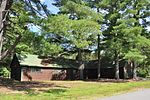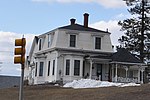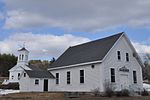Allenstown Meeting House
Allenstown, New HampshireChurches in Merrimack County, New HampshireChurches on the National Register of Historic Places in New HampshireCity and town halls in New HampshireCity and town halls on the National Register of Historic Places in New Hampshire ... and 5 more
Federal architecture in New HampshireFormer churches in New HampshireHouses completed in 1815National Register of Historic Places in Merrimack County, New HampshireNew Hampshire State Register of Historic Places

The Allenstown Meeting House (also known as Old Allenstown Meeting House; Church of Christ; Christian Church) is a historic meeting house on Deerfield Road in Allenstown, New Hampshire. Built in 1815, it is New Hampshire's only surviving Federal-style single-story meeting house to serve both religious and civic functions. It was listed on the National Register of Historic Places in December 2004, and the New Hampshire State Register of Historic Places in July 2004. It is presently owned and maintained by the town.
Excerpt from the Wikipedia article Allenstown Meeting House (License: CC BY-SA 3.0, Authors, Images).Allenstown Meeting House
Deerfield Road,
Geographical coordinates (GPS) Address Nearby Places Show on map
Geographical coordinates (GPS)
| Latitude | Longitude |
|---|---|
| N 43.160277777778 ° | E -71.381388888889 ° |
Address
Old Allenstown Meeting House
Deerfield Road 150
03275
New Hampshire, United States
Open on Google Maps










